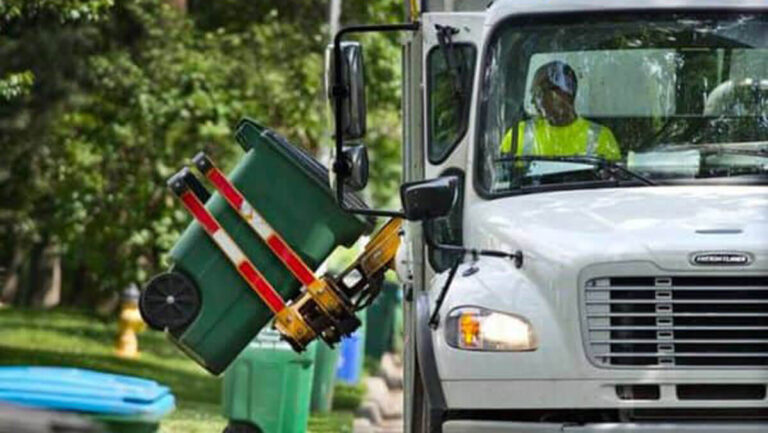Solid Waste Services Industry Distracted Driving Guidelines

The solid waste services industry employs more than 150,000 drivers on specialized commercial trucks. Ensuring their safety on the road is a number one priority for the industry. This document provides details on the definition of distracted driving, highlights state requirements that commercial trucking companies must follow, and offers guidance on training drivers to avoid distracted driving conditions.
According to the United States (U.S.) Department of Transportation (DOT), distracted driving is “any activity that could divert a person’s attention away from the primary task of driving.’’ There are four types of distractions:
- Visual – taking your eyes off the road
- Manual – taking your hands off the steering wheel
- Cognitive – taking your mind off what you are doing
- Auditory – hearing something not related to the road
While all driving distractions endanger the driver, passengers as well as bystanders are also endangered. Common distractions while driving include:
- Using cell phones (e.g., handheld and smart phones)
- Texting
- Eating and drinking
- Talking to passengers
- Grooming (e.g., putting on make-up, shaving)
- Reading (e.g., maps, newspapers)
- Using navigation systems
- Watching videos
- Adjusting radios, CD players, or MP3 players.
The U.S. DOT considers text messaging as a more serious distraction because drivers use visual, manual, and cognitive attention when sending these messages. Key facts regarding the consequences of distracted driving include:
- 3,092 people were killed and another 416,000 (estimated) injured because of distracted driving in 2010 (U.S. DOT 2012)
- 18 percent of all injury crashes in 2010 were reported as distraction-affected crashes (U.S. DOT 2012)
- 11 percent of all drivers under the age of 20 involved in fatal crashes were reported as distracted at the time of the crash (U.S. DOT 2012)
- Drivers using handheld devices are 4 times more likely to get into crashes serious enough to injure themselves (Hosking, S. et al. 2006)
- Text messaging creates a crash risk 23 times worse than driving while not distracted (Olson, R.L. et al. 2009)
- Sending or receiving a text takes a driver’s eyes from the road for an average of 4.6 second, which is equivalent to driving the length of an entire football field blind at 55 mile per hour (Olson, R.L. et al. 2009)
- Headset cell phone use is not substantially safer than handheld phone use (Olson, R.L. et al. 2009)
- Driving while using a cell phone reduces the amount of brain activity associated with driving by 37 percent (Just, M.A. et al. 2008)
Because of the dangers of either using a cell phone or sending and receiving text messages while driving, many states have banned or partially banned the practices. According to Governor’s Highway Safety Association (2012), the following states have enacted cell phone and texting bans:
Handheld Cell Phone Use:
- 8 states (California, Connecticut, Delaware, Nevada, New Jersey, New York, Oregon, Washington,) and the District of Columbia ban cell phone use and have primary enforcement (i.e., officers can ticket a driver without any other traffic offence)
- 2 states (Maryland and West Virginia) ban cell phone use and have secondary enforcement (i.e., officers can only ticket a driver if a driver has been pulled for another violation);
Text Messaging:
- 35 states (Alabama, Alaska, Arkansas, California, Colorado, Connecticut, Delaware, Georgia, Idaho, Illinois, Indiana, Kansas, Kentucky, Louisiana, Maine, Maryland, Massachusetts, Michigan, Minnesota, Nevada, New Hampshire, New Jersey, New York, North Carolina, North Dakota, Oregon, Pennsylvania, Rhode Island, Tennessee, Utah, Vermont, Washington, West Virginia, Wisconsin, and Wyoming) and the District of Colombia ban texting and have primary enforcement
- 4 states (Iowa, Nebraska, Ohio, and Virginia) ban texting and have secondary enforcement
Figure 1 shows the states that ban cell phone use while driving. Figure 2 shows the states that ban texting while driving. Research has shown that cell phones used for texting can increase fatal crashes by 6 to 23 times. However, only a limited number of experimentally controlled research studies have examined the dangers of texting and most studies were performed using a driving simulator not actual driving.
Because distracted driving poses a deadly risk to everyone on the road, companies should inform drivers of the risks and make sure that they understand what they should and should not do when driving company vehicles. Note that many of these distractions will apply to personal vehicles as well. To manage the most common driving distractions, companies should require drivers to:
- Turn off personal phones or switch them to silent mode before entering a company vehicle
- If drivers need to make a cell phone call, have them pull over to a safe area first
- Ask a helper or another passenger to make a return call for the driver
- Arrange times during the day for drivers to contact supervisors or dispatchers when the vehicle is parked
- Do not allow drivers to ever send or respond to text messages, surf the web, or read emails while driving because it is dangerous and against the law in most states
- Familiarize drivers with state and local laws before they drive a company vehicle
- Have drivers refrain from smoking, eating, drinking, reading, and any other activities that divert their attention from driving
References
Department of Transportation. 2012. What is Distracted Driving.
http://www.distraction.gov/content/get-the-facts/facts-and-statistics.html
Governors Highway Safety Association. 2012. Cell Phone and Texting Laws. Washington, DC.
http://www.ghsa.org/html/stateinfo/laws/cellphone_laws.html
Hosking, S., K. Young, and M. Regan. 2006. The Effects of Text Messaging on Young Novice Driver Performance. Monasah University Accident Research Centre. Victoria, Australia.
http://www.distraction.gov/research/PDF-Files/Effects-of-Text-Messaging.pdf
Just, M.A., T.A. Keller, and J. Cynkar. 2008. A decrease in brain activation associated with driving when listening to someone speak. Center for Cognitive Brain Imaging. Carnegie Mellon University. Bain Research 1205(2008). pp.70-80. http://www.distraction.gov/research/PDF-Files/carnegie-mellon.pdf
Olson, R.L., R.J. Hanowski, J.S. Hickman, and J. Bocanegra. 2009. Driver Distraction in Commercial Vehicle Operation. Center for Truck and Bus Safety. Virginia Tech Transportation Institute. Blacksburg, VA.
http://www.distraction.gov/research/PDF-Files/Driver-Distraction-Commercial-Vehicle-Operations.pdf
For more information on NSWMA’s Distracted While Driving, contact:
Edward W. Repa, PhD
Director, Environmental Programs
202-364-3773
